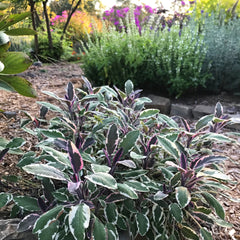The flavor of fresh, organic herbs cannot be beat. Herb gardens can be grown in any sunny area in containers or a garden bed. My first professional horticulture job was at a small herb nursery in Georgia. There I learned about wonderful herbs like Hyssop, Scented Geraniums and Thyme. I had no idea there were so many varieties of Thyme! I will cover a few herb garden basics as well as great herb plants for beginners and experienced gardeners. This first article will cover a few basic kitchen herbs. Check back for my next article that will cover the less common herbs (Borage, Hyssop) and the superstar- Lavender!
Most herbs will grow best in full sun and well drained soil. Many herbs are originally from the Mediterranean region so think sunny, warm and dry. I've gardened in the heavy clay soil of the South for most of my adult life. Water logged soil will cause most herbs to struggle and eventually succumb to root rot. This can vary by region and taking a soil sample to your local extension office is a great way to find out what kind of soil you are dealing with. I've spent years adding amendments such as compost to help build up my soil. This helps the soil retain nutrients and just the right amount of moisture.
Basil
 Basil is one of the most popular herbs for the summer garden. Basil will grow best once the temperatures really warm up in the spring. Basil resents cold, damp soil and can be stunted or die if planted out in the garden too early in the spring. The Basil pictured here is Cardinal Basil and is one of the prettiest herbs I grow. The blooms are also a favorite of florists and appear in summer bridal bouquets as well as arrangements.
Basil is one of the most popular herbs for the summer garden. Basil will grow best once the temperatures really warm up in the spring. Basil resents cold, damp soil and can be stunted or die if planted out in the garden too early in the spring. The Basil pictured here is Cardinal Basil and is one of the prettiest herbs I grow. The blooms are also a favorite of florists and appear in summer bridal bouquets as well as arrangements.
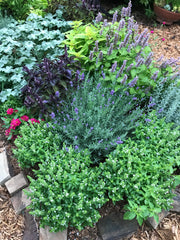
Dill
 Dill weed is one of the easiest herbs to grow from seed. It will grow best if direct sown into the garden once the spring temperatures have settled. The green, ferny foliage will pop up while the temperatures are still on the cool side. Dill is a terrific host plant for Swallowtail Butterflies. Don't be surprised to find the striped caterpillars munching away on the foliage. The plants will begin flowering in early summer. The large, yellow umbels are a favorite of small pollinators. I stagger my seedings so I have flowers available once the pickling cucumbers are ready to be canned.
Dill weed is one of the easiest herbs to grow from seed. It will grow best if direct sown into the garden once the spring temperatures have settled. The green, ferny foliage will pop up while the temperatures are still on the cool side. Dill is a terrific host plant for Swallowtail Butterflies. Don't be surprised to find the striped caterpillars munching away on the foliage. The plants will begin flowering in early summer. The large, yellow umbels are a favorite of small pollinators. I stagger my seedings so I have flowers available once the pickling cucumbers are ready to be canned.
Thyme
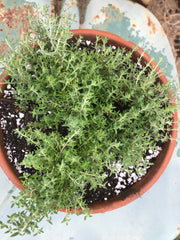
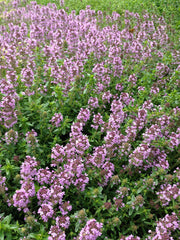 Pictured here is Creeping Thyme. It flowers in the mid summer and is loved by small bees and pollinators. Once flowering is done it can be sheared down. Most of the creeping thyme varieties can take very light foot traffic.
Pictured here is Creeping Thyme. It flowers in the mid summer and is loved by small bees and pollinators. Once flowering is done it can be sheared down. Most of the creeping thyme varieties can take very light foot traffic.
Sage
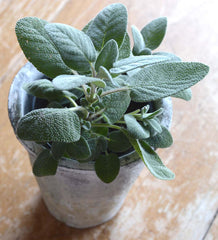 Sage is grown for it's soft green foliage. The fragrance is strong and a little goes a long way! Pictured here is green garden Sage. It can be fussy about soil and is a great herb to grow in a container garden where moisture levels can be controlled. Sage does come in several other colors and varieties. Purple Sage has lovely dark foliage but does not make it through my zone 6 winters very well. I think a very wet, cold winter is what causes it to not be hardy from season to season. Tricolor Sage is beautiful used as an edging plant.
Sage is grown for it's soft green foliage. The fragrance is strong and a little goes a long way! Pictured here is green garden Sage. It can be fussy about soil and is a great herb to grow in a container garden where moisture levels can be controlled. Sage does come in several other colors and varieties. Purple Sage has lovely dark foliage but does not make it through my zone 6 winters very well. I think a very wet, cold winter is what causes it to not be hardy from season to season. Tricolor Sage is beautiful used as an edging plant.
Rosemary
Rosemary is a favorite herb of chefs. This is one herb that will grow best if really given a Mediterranean growing environment. Rosemary really struggles through cold winters. I grow two varieties that are a little more cold tolerant, Arp and Hill's Hardy Rosemary. Some make it through the winter better than others. When I gardened in warmer Georgia my Rosemary plants grew lush and tall and make a wonderful evergreen shrub. Here in zone 6 (or 7 or 5 depending on the winter!) I am just happy when they survive. Each fall I take cuttings from the hardiest plants to grow through the winter on my light stand. Rosemary is well suited to pot culture and may stretch when grown indoors but can survive. I am not much of a cook but I do enjoy a few sprigs to flavor poultry and winter stews.
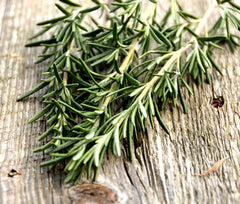
Chives
Chives are easy to grow from seed and can be very long lived in the garden. Large clumps of Chives will be covered in profuse purple blooms in late spring. The flowers are edible and make a lovely garnish. Chives will push up tender green shoots in early spring. The flavor is at it's strongest when the shoots are small and before flowering. The flowers are great in the garden as they are an early nectar source for the bees.
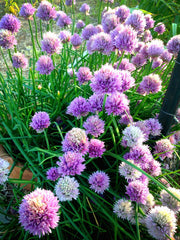 Garlic Chives have flattened foliage and a much stronger, garlic flavor. The plants are equally ornamental in the garden. Garlic Chives begin blooming in mid summer and have a white, star like bloom.
Garlic Chives have flattened foliage and a much stronger, garlic flavor. The plants are equally ornamental in the garden. Garlic Chives begin blooming in mid summer and have a white, star like bloom.
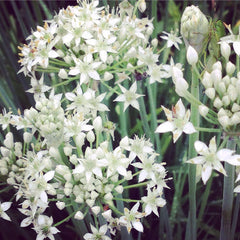
Parsley
Flat Leaf Italian Parsley is the preferred variety for cooking. Curled Parsley is the one used more traditionally as a garnish. I use whatever I have available! Parsley is also an excellent host plant for Swallowtail Butterfly larvae. It is easy to grow and I always plant enough for my use as well as food for the caterpillars. Parsley, once established, can take cooler temperatures and is often planted in early spring with other cool season flowers such as Calendula and Pansies.
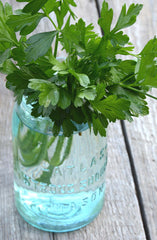
I will continue to explore the wonderful world of herbs in my next post. Be sure to check back!
